This article needs additional citations for verification .(May 2011) |

Slitherlink (also known as Fences, Takegaki, Loop the Loop, Loopy, Ouroboros, Suriza, Rundweg and Dotty Dilemma) is a logic puzzle developed by publisher Nikoli.
This article needs additional citations for verification .(May 2011) |

Slitherlink (also known as Fences, Takegaki, Loop the Loop, Loopy, Ouroboros, Suriza, Rundweg and Dotty Dilemma) is a logic puzzle developed by publisher Nikoli.
Slitherlink is played on a rectangular lattice of dots. Some of the squares formed by the dots have numbers inside them. The objective is to connect horizontally and vertically adjacent dots so that the lines form a simple loop with no loose ends. In addition, the number inside a square represents how many of its four sides are segments in the loop.
Other types of planar graphs can be used in lieu of the standard grid, with varying numbers of edges per vertex or vertices per polygon. These patterns include snowflake, Penrose, Laves and Altair tilings. These add complexity by varying the number of possible paths from an intersection, and/or the number of sides to each polygon; but similar rules apply to their solution.
This section contains instructions, advice, or how-to content .(February 2013) |
Whenever the number of lines around a cell matches the number in the cell, the other potential lines must be eliminated. This is usually indicated by marking an X on lines known to be empty.
Another useful notation when solving Slitherlink is a ninety degree arc between two adjacent lines, to indicate that exactly one of the two must be filled. A related notation is a double arc between adjacent lines, indicating that both or neither of the two must be filled. These notations are not necessary to the solution, but can be helpful in deriving it.

Many of the methods below can be broken down into two simpler steps by use of arc notation.
A key to many deductions in Slitherlink is that every point has either exactly two lines connected to it, or no lines. So if a point which is in the centre of the grid, not at an edge or corner, has three incoming lines which are X'd out, the fourth must also be X'd out. This is because the point cannot have just one line - it has no exit route from that point. Similarly, if a point on the edge of the grid, not at a corner, has two incoming lines which are X'd out, the third must also be X'd out. And if a corner of the grid has one incoming line which is X'd out, the other must also be X'd out.
Application of this simple rule leads to increasingly complex deductions. Recognition of these simple patterns will help greatly in solving Slitherlink puzzles.



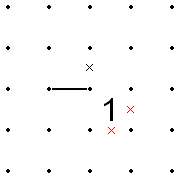
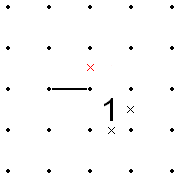


If a 2 has any surrounding line X’d, then a line coming into either of the two corners not adjacent to the X’d out line cannot immediately exit at right angles away from the 2, as then two lines around the 2 would be impossible, and can therefore be X’d. This means that the incoming line must continue on one side of the 2 or the other. This in turn means that the second line of the 2 must be on the only remaining free side, adjacent to the originally X’d line, so that can be filled in.
Conversely, if a 2 has a line on one side, and an adjacent X’d out line, then the second line must be in one of the two remaining sides, and exit from the opposite corner (in either direction). If either of those two exits is X’d out, then it must take the other route.













If a region of the lattice is closed-off (such that no lines can "escape"), and is not empty, there must be a non-zero, even number of lines entering the region that begin outside the region. (An odd number of lines entering implies an odd number of segment ends inside the region, which makes it impossible for all the segment ends to connect. If there are no such lines, the lines inside the region cannot connect with the lines outside, making a solution impossible.) Often, this rule will eliminate one or more otherwise feasible options.
In the figure below, the line at the top-left will close off the top-right region of the lattice whether it proceeds down or to the right. The line to the right (around two sides of the 3) has entered the closed region. To satisfy the rule, the first line must enter the region, and the second line must not enter the region a second time. (Since the boundary of any closed region also closes off the remainder of the puzzle, the rule can also be applied to the larger, bottom-left region. To apply the rule, it is only necessary to count the lines crossing the boundary.)

In an exceptionally difficult puzzle, one may use the Jordan curve theorem, which states that any open curve that starts and ends outside of a closed curve must intersect the closed curve an even number of times. In particular, this means that any row of the grid must have an even number of vertical lines and any column must have an even number of horizontal lines. When only one potential line segment in one of these groups is unknown, you can determine whether it is part of the loop or not with this theorem. This also means that if you mentally trace an arbitrary path from an outer edge of the grid, to another outer edge of the grid, the path will intersect the closed curve an even number of times.
A simple strategy to assist in using this theorem is to "paint" (sometimes called "shade") the outside and the inside areas. When you see two outside cells, or two inside cells next to each other, then you know that there is not a line between them. The converse is also true: if you know there is no line between two cells, then those cells must be the same "color" (both inside or both outside). Similarly, if an outside cell and an inside cell are adjacent, you know there must be a filled line between them; and again the converse is true.
In the figure below, if a solution could pass through the top and right sides of the 2, then there must be another solution which is exactly the same except that it passes through the bottom and left sides of the 2, because the squares to the top and right of the 2 are unconstrained (do not contain numbers). Also, the solution must pass through the top-right corner of the 2, otherwise there must be another solution which is exactly the same except that it passes through the top and right sides of the 2.

If there is a 2 in a corner, and the two non-diagonally adjacent squares are unconstrained, lines can be drawn as shown below. (In the figure, the question mark represents any number or blank, but the number will only be a 2 or 3. A puzzle with only one solution cannot have a 2 in a corner with two non-diagonally adjacent, unconstrained squares, and a diagonally adjacent 0 or 1.)

In the figure below, the circled points can be connected by a line directly between them, and also by a line that traverses the other three sides of the square that extends to the left of the points. It should be clear (with the red line ignored) that for both paths the remainder of the solution can be the same – since the constraints for the remainder of the solution are the same – so both paths are ruled out.

Slitherlink is an original puzzle of Nikoli; it first appeared in Puzzle Communication Nikoli #26 (June 1989). The editor combined two original puzzles contributed there. At first, every square contained a number and the edges did not have to form a loop.
Slitherlink puzzles have been featured in video games on several platforms. A game titled Slither Link was published in Japan by Bandai for the Wonderswan portable console in 2000. [1] Slitherlink puzzles were included alongside Sudoku and Nonogram puzzles in the Loppi Puzzle Magazine: Kangaeru Puzzle series of games from Success for the Game Boy Nintendo Power cartridge in 2001. [2] Slitherlink games were also featured for the Nintendo DS handheld game console, with Hudson Soft releasing Puzzle Series Vol. 5: Slitherlink in Japan on November 16, 2006, and Agetec including Slitherlink in its Nikoli puzzle compilation, Brain Buster Puzzle Pak, released in North America on June 17, 2007. [3]

Tic-tac-toe, noughts and crosses, or Xs and Os is a paper-and-pencil game for two players who take turns marking the spaces in a three-by-three grid with X or O. The player who succeeds in placing three of their marks in a horizontal, vertical, or diagonal row is the winner. It is a solved game, with a forced draw assuming best play from both players.

Nonograms, also known as Hanjie, Paint by Numbers, Picross, Griddlers, and Pic-a-Pix are picture logic puzzles in which cells in a grid must be colored or left blank according to numbers at the edges of the grid to reveal a hidden picture. In this puzzle, the numbers are a form of discrete tomography that measures how many unbroken lines of filled-in squares there are in any given row or column. For example, a clue of "4 8 3" would mean there are sets of four, eight, and three filled squares, in that order, with at least one blank square between successive sets.

Kakuro or Kakkuro or Kakoro is a kind of logic puzzle that is often referred to as a mathematical transliteration of the crossword. Kakuro puzzles are regular features in many math-and-logic puzzle publications across the world. In 1966, Canadian Jacob E. Funk, an employee of Dell Magazines, came up with the original English name Cross Sums and other names such as Cross Addition have also been used, but the Japanese name Kakuro, abbreviation of Japanese kasan kurosu, seems to have gained general acceptance and the puzzles appear to be titled this way now in most publications. The popularity of Kakuro in Japan is immense, second only to Sudoku among Nikoli's famed logic-puzzle offerings.

Sudoku is a logic-based, combinatorial number-placement puzzle. In classic Sudoku, the objective is to fill a 9 × 9 grid with digits so that each column, each row, and each of the nine 3 × 3 subgrids that compose the grid contains all of the digits from 1 to 9. The puzzle setter provides a partially completed grid, which for a well-posed puzzle has a single solution.

Nurikabe is a binary determination puzzle named for Nurikabe, an invisible wall in Japanese folklore that blocks roads and delays foot travel. Nurikabe was apparently invented and named by Nikoli; other names for the puzzle include Cell Structure and Islands in the Stream.

Hitori is a type of logic puzzle published by Nikoli.
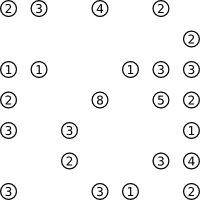
Hashiwokakero is a type of logic puzzle published by Nikoli. It has also been published in English under the name Bridges or Chopsticks. It has also appeared in The Times under the name Hashi. In France, Denmark, the Netherlands, and Belgium it is published under the name Ai-Ki-Ai.
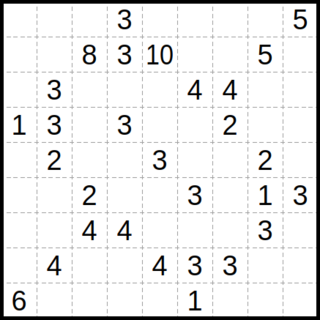
Fillomino (フィルオミノ) is a type of logic puzzle published by many publishers. Other published titles for the puzzle include Allied Occupation.

Masyu is a type of logic puzzle designed and published by Nikoli. The purpose of its creation was to present a puzzle that uses no numbers or letters and yet retains depth and aesthetics.

Heyawake is a binary-determination logic puzzle published by Nikoli. As of 2013, five books consisting entirely of Heyawake puzzles have been published by Nikoli. It first appeared in Puzzle Communication Nikoli #39.
Light Up, also called Akari is a binary-determination logic puzzle published by Nikoli. As of 2011, three books consisting entirely of Light Up puzzles have been published by Nikoli.

Killer sudoku is a puzzle that combines elements of sudoku and kakuro. Despite the name, the simpler killer sudokus can be easier to solve than regular sudokus, depending on the solver's skill at mental arithmetic; the hardest ones, however, can take hours to solve.

This is a glossary of Sudoku terms and jargon. It is organized thematically, with links to references and example usage provided as ([1]). Sudoku with a 9×9 grid is assumed, unless otherwise noted.

Inshi no heya is a type of logic puzzle published by Nikoli. It is a specific form of the KenKen puzzle genre where every operation is implied to be multiplication.

Hotaru Beam is a binary-determination logic puzzle published by Nikoli.

Bag is a binary-determination logic puzzle published by Nikoli.

Gokigen Naname, also known as Slant, is a binary-determination logic puzzle published by Nikoli.
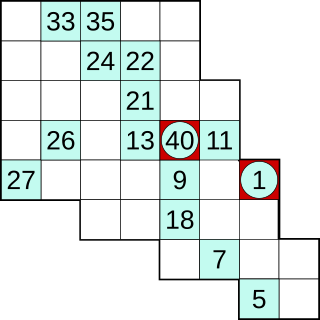
Hidato, also known as "Hidoku", is a logic puzzle game invented by Dr. Gyora M. Benedek, an Israeli mathematician. The goal of Hidato is to fill the grid with consecutive numbers that connect horizontally, vertically, or diagonally. The name Hidato is a registered trademark. Some publishers use different names for this puzzle such as Number Snake, Snakepit, Jadium or Numbrix.

Shakashaka (シャカシャカ) is a logic puzzle developed by publisher Nikoli.
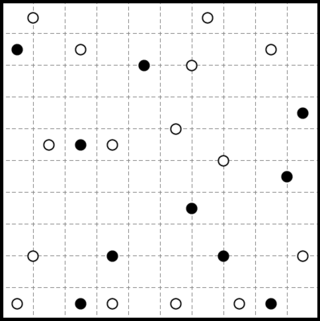
Tentai Show, also known by the names Tentaisho, Galaxies, Spiral Galaxies, or Sym-a-Pix, is a binary-determination logic puzzle published by Nikoli.